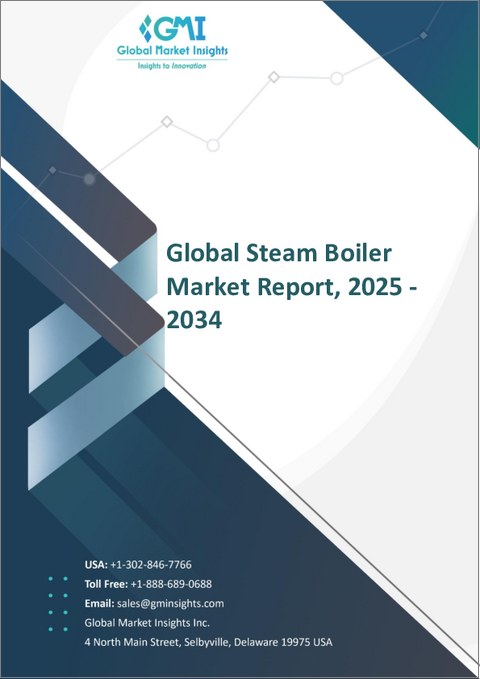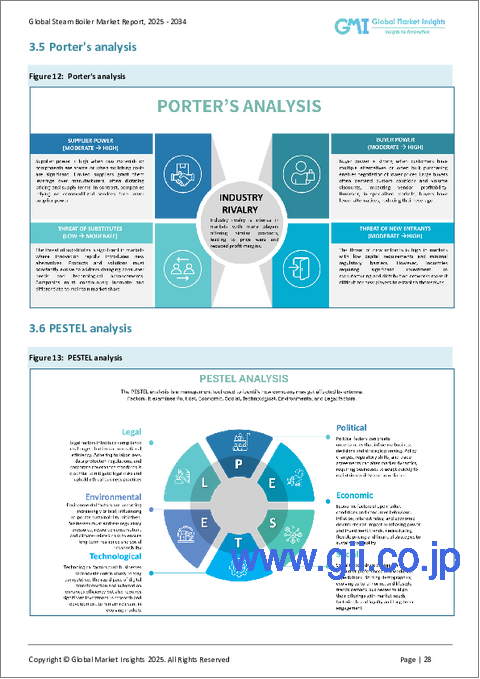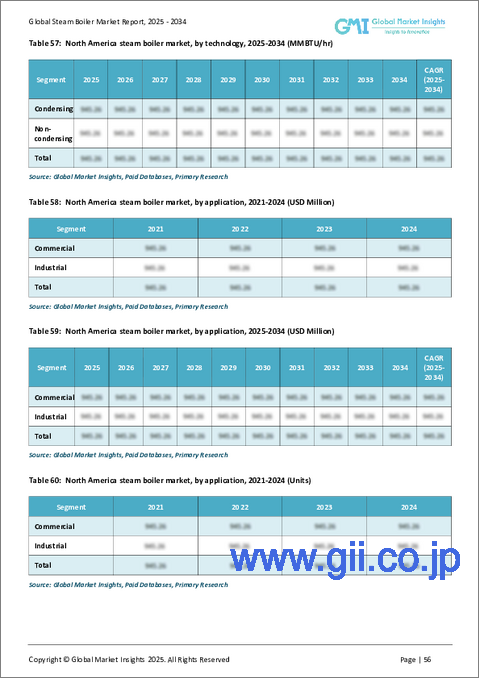|
|
市場調査レポート
商品コード
1750542
蒸気ボイラーの市場機会、成長促進要因、産業動向分析、2025~2034年予測Steam Boiler Market Opportunity, Growth Drivers, Industry Trend Analysis, and Forecast 2025 - 2034 |
||||||
カスタマイズ可能
|
|||||||
| 蒸気ボイラーの市場機会、成長促進要因、産業動向分析、2025~2034年予測 |
|
出版日: 2025年05月02日
発行: Global Market Insights Inc.
ページ情報: 英文 130 Pages
納期: 2~3営業日
|
全表示
- 概要
- 目次
世界の蒸気ボイラー市場は、2024年に144億米ドルと評価され、主要な世界経済における急速な工業化とエネルギーインフラへの大規模な投資に牽引され、CAGR 5.3%で成長し、2034年には245億米ドルに達すると推定されます。
産業界全体における効率的な蒸気発生システムへの需要の高まりと、商業および産業環境における空間暖房への使用の増加が、市場拡大を後押しします。さらに、可処分所得の増加と生活水準の向上が、特に寒冷地では蒸気ボイラーの需要を押し上げると思われます。これらの要因は、産業運営におけるカーボンフットプリントの削減への関心の高まりと相まって、市場の成長をさらに押し上げると思われます。

排出量削減の動向も、市場の形成に重要な役割を果たしています。各国政府はNOxとSOxの排出に関してより厳しい規制を実施しており、これが高圧ボイラーを含む先進技術の採用を産業界に促しています。さらに、遠隔監視、予知保全、最適化された負荷管理などのデジタル技術を取り入れることで、運転がより効率的になり、計画外のシャットダウンが減り、システムの信頼性が高まる。このような技術進歩により、より高度な蒸気ボイラーに対する需要も増加します。
| 市場範囲 | |
|---|---|
| 開始年 | 2024 |
| 予測年 | 2025-2034 |
| 開始金額 | 144億米ドル |
| 予測金額 | 245億米ドル |
| CAGR | 5.3% |
コンデンシング蒸気ボイラー市場は、エネルギー価格の上昇と厳しい排出規制への対応ニーズの高まりにより、2034年までに150億米ドルに達すると予測されています。コンデンシングボイラーは高効率で、従来のシステムよりも燃費が良く、二酸化炭素排出量が少ないため、運用コストと環境フットプリントの両方を削減したい産業にとって好ましい選択肢となっています。エネルギー効率の高い技術を促進する政府の優遇措置は、こうしたシステムの採用をさらに後押しし、市場の成長に勢いを与えています。
一方、石油を燃料とする蒸気ボイラー市場は、2034年までCAGR 4%で成長すると予測されています。これらのボイラーは、石油化学、製油所、熱油処理などの重工業で特に人気があります。石油燃焼ボイラーは、その高いターンダウン比が評価され、需要の変化に応じて蒸気流量を正確に調整することができます。この適応性により、負荷条件が変化しても安定した信頼性の高い蒸気供給を必要とする産業用途には不可欠なものとなっています。これらのシステムに対する継続的な需要は、高需要環境におけるその信頼性と性能によって引き続き牽引されるでしょう。
米国の蒸気ボイラーの市場規模は2024年には23億米ドルとなり、、これは新しい製造施設への多額の投資と、旧式の暖房システムを最新のエネルギー効率の高いボイラー技術に置き換えるという継続的な動向に起因しています。産業界がエネルギー消費の削減と持続可能性の目標達成に注力する中、先進的な蒸気ボイラーシステムの需要は増加の一途をたどっています。さらに、米国ではインフラの近代化が進んでおり、産業・商業部門の両方で効率的な蒸気発生ソリューションの需要がさらに高まっています。
蒸気ボイラーの世界市場に参入している企業は、市場シェア拡大のために戦略的イノベーションと事業拡大に注力しています。例えば、厳しい環境規制に対応し、よりエネルギー効率の高いソリューションを提供するために、ボイラー技術の進歩に注力している企業もあります。また、各社はデジタル監視ツールに投資し、運転管理の向上とボイラーの長寿命化を図っています。同市場の主要企業には、Aggreko、ALFA LAVAL、Miura America、Thermaxなどがあり、いずれも技術革新を推進し、製品の多様化と世界展開を通じて市場での地位強化を図っています。各社の戦略には、エネルギー効率の高いソリューションへの注力や、顧客満足度とロイヤルティを高めるためのアフターセールス・サポートの強化も含まれています。
目次
第1章 調査手法と範囲
第2章 エグゼクティブサマリー
第3章 業界考察
- エコシステム分析
- トランプ政権の関税分析
- 貿易への影響
- 貿易量の混乱
- 報復措置
- 業界への影響
- 供給側の影響(原材料)
- 主要原材料の価格変動
- サプライチェーンの再構築
- 生産コストへの影響
- 需要側の影響(販売価格)
- 最終市場への価格伝達
- 市場シェアの動向
- 消費者の反応パターン
- 供給側の影響(原材料)
- 影響を受ける主要企業
- 戦略的な業界対応
- サプライチェーンの再構成
- 価格設定と製品戦略
- 政策関与
- 展望と今後の検討事項
- 貿易への影響
- 規制情勢
- 業界への影響要因
- 促進要因
- 業界の潜在的リスク&課題
- 成長可能性分析
- ポーター分析
- PESTEL分析
第4章 競合情勢
- イントロダクション
- 戦略的ダッシュボード
- 戦略的取り組み
- 企業の市場シェア分析
- 競合ベンチマーキング
- イノベーションと持続可能性の情勢
第5章 市場規模・予測:燃料別、2021-2034
- 主要動向
- 天然ガス
- 油
- 石炭
- その他
第6章 市場規模・予測:容量別、2021-2034
- 主要動向
- 10 MMBTU/時未満
- 10~50 MMBTU/時以上
- 50~100 MMBTU/時以上
- 100~250 MMBTU/時以上
- 250 MMBTU/時以上
第7章 市場規模・予測:技術別、2021-2034
- 主要動向
- 凝縮
- 不凝縮
第8章 市場規模・予測:用途別、2021-2034
- 主要動向
- 商業用
- 容量
- 10 MMBTU/時未満
- 10~50 MMBTU/時以上
- 50~100 MMBTU/時以上
- 100~250 MMBTU/時以上
- 250 MMBTU/時以上
- 燃料
- 天然ガス
- 油
- 石炭
- その他
- テクノロジー
- 凝縮
- 不凝縮
- 容量
- 産業
- 容量
- 10 MMBTU/時未満
- 10~50 MMBTU/時以上
- 50~100 MMBTU/時以上
- 100~250 MMBTU/時以上
- 250 MMBTU/時以上
- 燃料
- 天然ガス
- 油
- 石炭
- その他
- テクノロジー
- 凝縮
- 不凝縮
- 容量
第9章 市場規模・予測:地域別、2021-2034
- 主要動向
- 北米
- 米国
- カナダ
- メキシコ
- 欧州
- フランス
- 英国
- ポーランド
- イタリア
- スペイン
- オーストリア
- ドイツ
- スウェーデン
- ロシア
- アジア太平洋地域
- 中国
- インド
- フィリピン
- 日本
- 韓国
- オーストラリア
- インドネシア
- 中東・アフリカ
- サウジアラビア
- イラン
- アラブ首長国連邦
- ナイジェリア
- 南アフリカ
- ラテンアメリカ
- アルゼンチン
- チリ
- ブラジル
第10章 企業プロファイル
- Aggreko
- ALFA LAVAL
- Babcock &Wilcox
- Babcock Wanson
- Bosch Industriekessel
- Clayton Industries
- Cleaver-Brooks
- Cochran
- FERROLI
- Forbes Marshall
- Fulton
- GE Vernova
- Hoval
- Hurst Boiler &Welding
- John Cockerill
- Miura America
- P.M. Lattner Manufacturing
- PARKER BOILER
- Precision Boilers
- Thermax
- VIESSMANN
- Weil-McLain
The Global Steam Boiler Market was valued at USD 14.4 billion in 2024 and is estimated to grow at a CAGR of 5.3% to reach USD 24.5 billion by 2034, driven by the rapid industrialization in key global economies and substantial investments in energy infrastructure. A growing demand for efficient steam generation systems across industries, along with their increasing use for space heating in commercial and industrial settings, will support market expansion. Additionally, the rising disposable income and improved living standards, especially in colder regions, will drive the demand for steam boilers. These factors, combined with a heightened focus on reducing carbon footprints in industrial operations, will further boost the market's growth.

The trend toward reducing emissions is also playing a crucial role in shaping the market. Governments are implementing stricter regulations on NOx and SOx emissions, which is encouraging industries to adopt advanced technologies, including high-pressure boilers. Moreover, the incorporation of digital technologies such as remote monitoring, predictive maintenance, and optimized load management will make operations more efficient, reducing unplanned shutdowns and enhancing system reliability. This technological advancement will also increase demand for more sophisticated steam boilers.
| Market Scope | |
|---|---|
| Start Year | 2024 |
| Forecast Year | 2025-2034 |
| Start Value | $14.4 Billion |
| Forecast Value | $24.5 Billion |
| CAGR | 5.3% |
The condensing steam boiler market is projected to reach USD 15 billion by 2034, driven by the rising energy prices and the increasing need to comply with stringent emissions regulations. Condensing boilers are highly efficient, offering better fuel economy and lower carbon emissions compared to traditional systems, making them a preferred choice for industries looking to reduce both operational costs and their environmental footprint. Government incentives promoting energy-efficient technologies are further encouraging the adoption of these systems, adding momentum to the market's growth.
On the other hand, the oil-fueled steam boiler market is anticipated to grow at a CAGR of 4% until 2034. These boilers are particularly popular in heavy industries such as petrochemicals, refineries, and thermal oil processing. Oil-fired boilers are valued for their high turndown ratios, allowing them to adjust steam flow precisely according to changing demand. This adaptability makes them indispensable in industrial applications that require a consistent and reliable steam supply under varying load conditions. The ongoing demand for these systems will continue to be driven by their reliability and performance in high-demand environments.
United States Steam Boiler Market generated USD 2.3 billion in 2024, attributed to substantial investments in new manufacturing facilities and the ongoing trend of replacing outdated heating systems with modern, energy-efficient boiler technologies. As industries focus on reducing energy consumption and meeting sustainability goals, the demand for advanced steam boiler systems continues to rise. Additionally, the U.S. is experiencing an ongoing modernization of infrastructure, further driving the demand for efficient steam generation solutions in both the industrial and commercial sectors.
Companies in the Global Steam Boiler Market are focusing on strategic innovations and expansion to enhance their market share. For example, some players are focusing on advancing boiler technology to meet stringent environmental regulations and provide more energy-efficient solutions. The companies are also investing in digital monitoring tools to offer better control over operations and increase boiler longevity. Key players in the market include Aggreko, ALFA LAVAL, Miura America, and Thermax, all of which are driving innovation and aiming to strengthen their market positions through product diversification and global expansion. Their strategies also include focusing on energy-efficient solutions and strengthening after-sales support to enhance customer satisfaction and loyalty.
Table of Contents
Chapter 1 Methodology & Scope
- 1.1 Research design
- 1.2 Market estimates & forecast parameters
- 1.3 Forecast calculation
- 1.4 Data sources
- 1.4.1 Primary
- 1.4.2 Secondary
- 1.4.2.1 Paid
- 1.4.2.2 Public
- 1.5 Market scope & definitions
Chapter 2 Executive Summary
- 2.1 Industry synopsis, 2021 - 2034
Chapter 3 Industry Insights
- 3.1 Industry ecosystem analysis
- 3.2 Trump administration tariffs analysis
- 3.2.1 Impact on trade
- 3.2.1.1 Trade volume disruptions
- 3.2.1.2 Retaliatory measures
- 3.2.2 Impact on the industry
- 3.2.2.1 Supply-side impact (raw material)
- 3.2.2.1.1 Price volatility in key materials
- 3.2.2.1.2 Supply chain restructuring
- 3.2.2.1.3 Production cost implications
- 3.2.2.2 Demand-side impact (selling price)
- 3.2.2.2.1 Price transmission to end markets
- 3.2.2.2.2 Market share dynamics
- 3.2.2.2.3 Consumer response patterns
- 3.2.2.1 Supply-side impact (raw material)
- 3.2.3 Key companies impacted
- 3.2.4 Strategic industry responses
- 3.2.4.1 Supply chain reconfiguration
- 3.2.4.2 Pricing and product strategies
- 3.2.4.3 Policy engagement
- 3.2.5 Outlook and future considerations
- 3.2.1 Impact on trade
- 3.3 Regulatory landscape
- 3.4 Industry impact forces
- 3.4.1 Growth drivers
- 3.4.2 Industry pitfalls & challenges
- 3.5 Growth potential analysis
- 3.6 Porter's analysis
- 3.6.1 Bargaining power of suppliers
- 3.6.2 Bargaining power of buyers
- 3.6.3 Threat of new entrants
- 3.6.4 Threat of substitutes
- 3.7 PESTEL analysis
Chapter 4 Competitive Landscape, 2025
- 4.1 Introduction
- 4.2 Strategic dashboard
- 4.3 Strategic initiatives
- 4.4 Company market share analysis, 2024
- 4.5 Competitive benchmarking
- 4.6 Innovation & sustainability landscape
Chapter 5 Market Size and Forecast, By Fuel, 2021 - 2034 (Units, MMBTU/hr & USD Million)
- 5.1 Key trends
- 5.2 Natural gas
- 5.3 Oil
- 5.4 Coal
- 5.5 Others
Chapter 6 Market Size and Forecast, By Capacity, 2021 - 2034 (Units, MMBTU/hr & USD Million)
- 6.1 Key trends
- 6.2 ≤ 10 MMBTU/hr
- 6.3 > 10 - 50 MMBTU/hr
- 6.4 > 50 - 100 MMBTU/hr
- 6.5 > 100 - 250 MMBTU/hr
- 6.6 > 250 MMBTU/hr
Chapter 7 Market Size and Forecast, By Technology, 2021 - 2034 (Units, MMBTU/hr & USD Million)
- 7.1 Key trends
- 7.2 Condensing
- 7.3 Non-condensing
Chapter 8 Market Size and Forecast, By Application, 2021 - 2034 (Units, MMBTU/hr & USD Million)
- 8.1 Key trends
- 8.2 Commercial
- 8.2.1 Capacity
- 8.2.1.1 ≤ 10 MMBTU/hr
- 8.2.1.2 > 10 - 50 MMBTU/hr
- 8.2.1.3 > 50 - 100 MMBTU/hr
- 8.2.1.4 > 100 - 250 MMBTU/hr
- 8.2.1.5 > 250 MMBTU/hr
- 8.2.2 Fuel
- 8.2.2.1 Natural gas
- 8.2.2.2 Oil
- 8.2.2.3 Coal
- 8.2.2.4 Others
- 8.2.3 Technology
- 8.2.3.1 Condensing
- 8.2.3.2 Non-condensing
- 8.2.1 Capacity
- 8.3 Industrial
- 8.3.1 Capacity
- 8.3.1.1 ≤ 10 MMBTU/hr
- 8.3.1.2 > 10 - 50 MMBTU/hr
- 8.3.1.3 > 50 - 100 MMBTU/hr
- 8.3.1.4 > 100 - 250 MMBTU/hr
- 8.3.1.5 > 250 MMBTU/hr
- 8.3.2 Fuel
- 8.3.2.1 Natural gas
- 8.3.2.2 Oil
- 8.3.2.3 Coal
- 8.3.2.4 Others
- 8.3.3 Technology
- 8.3.3.1 Condensing
- 8.3.3.2 Non-condensing
- 8.3.1 Capacity
Chapter 9 Market Size and Forecast, By Region, 2021 - 2034 (Units, MMBTU/hr & USD Million)
- 9.1 Key trends
- 9.2 North America
- 9.2.1 U.S.
- 9.2.2 Canada
- 9.2.3 Mexico
- 9.3 Europe
- 9.3.1 France
- 9.3.2 UK
- 9.3.3 Poland
- 9.3.4 Italy
- 9.3.5 Spain
- 9.3.6 Austria
- 9.3.7 Germany
- 9.3.8 Sweden
- 9.3.9 Russia
- 9.4 Asia Pacific
- 9.4.1 China
- 9.4.2 India
- 9.4.3 Philippines
- 9.4.4 Japan
- 9.4.5 South Korea
- 9.4.6 Australia
- 9.4.7 Indonesia
- 9.5 Middle East & Africa
- 9.5.1 Saudi Arabia
- 9.5.2 Iran
- 9.5.3 UAE
- 9.5.4 Nigeria
- 9.5.5 South Africa
- 9.6 Latin America
- 9.6.1 Argentina
- 9.6.2 Chile
- 9.6.3 Brazil
Chapter 10 Company Profiles
- 10.1 Aggreko
- 10.2 ALFA LAVAL
- 10.3 Babcock & Wilcox
- 10.4 Babcock Wanson
- 10.5 Bosch Industriekessel
- 10.6 Clayton Industries
- 10.7 Cleaver-Brooks
- 10.8 Cochran
- 10.9 FERROLI
- 10.10 Forbes Marshall
- 10.11 Fulton
- 10.12 GE Vernova
- 10.13 Hoval
- 10.14 Hurst Boiler & Welding
- 10.15 John Cockerill
- 10.16 Miura America
- 10.17 P.M. Lattner Manufacturing
- 10.18 PARKER BOILER
- 10.19 Precision Boilers
- 10.20 Thermax
- 10.21 VIESSMANN
- 10.22 Weil-McLain






